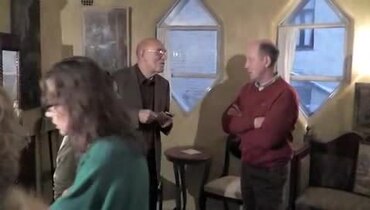Konstantin Stepanowitsch Melnikow
Konstantin Melnikov ( Russian Константин Степанович Мельников ., Scientific transliteration Konstantin Mel'nikov Stepanovič * July 22 . Jul / 3. August 1890 greg. In Moscow , † 28 November 1974 ) was a Soviet architect , of the rationalists is counted.
Life
Melnikow was born into a working-class family in 1890 and graduated from a church-oriented school in 1902. He then worked as a runner in a trading company. In 1905, with the help of a rich sponsor, he entered the Moscow School of Painting , Architecture and Sculpture , where he graduated in painting in 1914 and in architecture in 1917 .
His first work was still characterized by the classicist architecture of the turn of the century, such as his contributions to the first Russian car factory AMO in Moscow, where he experienced the October Revolution while working from 1916 to 1918 . In the following years he was involved in several construction projects.
His teaching activity at the Moscow State Artistic-Technical Master School ( Wchutemas / Вхутемас) meant a change of direction . The first result of his new style was the Machorka exhibition pavilion at the All-Russian Agricultural and Crafts Exhibition in 1923. The sarcophagus for the Lenin mausoleum was built in 1924 according to Melnikov's designs.
The Soviet pavilion at the Paris International Applied Arts Exhibition in 1925 attracted international attention: the building, a combination of glass and wooden frame elements, was considered one of the most progressive structures in the exhibition. Influences of Vladimir Tatlin, who was five years his senior, and his constructivism were visible.
Other projects in Moscow were the Rubber Clubhouse (1927/28) and the Rusakow Culture House (1927/29). In the same year the car park for the state planning authority Gosplan in Moscow was built according to his plans . Between 1926 and 1929 , the central garage for trucks and buses, popularly known as the horseshoe garage, with an attached workshop was built on Novo-Ryazanskaya Street in Moscow .
Despite the high technical level of his buildings, Melnikow repeatedly questioned the basic premise of functionality; his works were often more reminiscent of abstract sculptures than functional buildings. One of his most famous buildings, the "Melnikow House" (1928–1931) on Moscow's Krivoyarbatsky Alley (Krivoybatsky Pereulok 10), consists of two cylindrical towers interrupted by hexagonal windows. From 1934 to 1937 Melnikov taught at the Moscow Architecture Institute; During this time he already experienced criticism of his "fantasies" and was no longer able to realize many of his designs. He lived a secluded life and did not come back to the public until 1964 with a competition entry for the pavilion at the 1967 World's Fair in Montreal .
Melnikov died on November 28, 1974 in Moscow and was buried there in the Vvedenskoye cemetery .
literature
- Mario Fosso et al. (Ed.): Konstantin S. Mel'nikov and the Construction of Moscow . Skira, Milan 2000.
- S. Frederick Starr : Melnikov. Solo Architect in a Mass Society , Princeton University Press, Princeton, New Jersey, USA 1978. ISBN 0-691-03931-3 .
Web links
- Konstantin Stepanowitsch Melnikow. In: arch INFORM .
- Space as the most important building material. Russian architect Konstantin Melnikow , DeutschlandRadio Berlin, February 25, 2005
| personal data | |
|---|---|
| SURNAME | Melnikow, Konstantin Stepanowitsch |
| ALTERNATIVE NAMES | Мельников, Константин Степанович (Russian); Mel'nikov, Konstantin Stepanovič (scientific transliteration) |
| BRIEF DESCRIPTION | Russian architect |
| DATE OF BIRTH | August 3, 1890 |
| PLACE OF BIRTH | Moscow , Russian Empire |
| DATE OF DEATH | November 28, 1974 |
| Place of death | Moscow , Soviet Union |



